KLay Layered Layout Options
KLay Layered supports a whole bunch of layout options. Every single one of them is documented here.
Contents
- Overview
- Detailed Documentation
- KLay Layered Layout Options
- KLay Layered Layout Options
- KLay Layered Layout Options
- KLay Layered Layout Options
- KLay Layered Layout Options
- KLay Layered Layout Options
- KLay Layered Layout Options
- KLay Layered Layout Options
- KLay Layered Layout Options
- KLay Layered Layout Options
- KLay Layered Layout Options
- KLay Layered Layout Options
- KLay Layered Layout Options
- KLay Layered Layout Options
- KLay Layered Layout Options
- KLay Layered Layout Options
- KLay Layered Layout Options
- KLay Layered Layout Options
Overview
For a general introduction on layout options, see the KIML documentation. KLay Layered supports layout options defined by KIML and defines additional custom layout options.
Supported KIML Layout Options
KLay Layered supports the following standard layout options defined by KIML. Note that the default value may be altered (highlighted yellow). These layout options are documented on KIML's Layout Options page.
Option | ID | Type | Applies to | Default |
|---|---|---|---|---|
Additional Port Space | de.cau.cs.kieler.additionalPortSpace | Margins | Nodes | 0, 0, 0, 0 |
Alignment | de.cau.cs.kieler.alignment | Enum | Nodes | AUTOMATIC |
Aspect Ratio | de.cau.cs.kieler.aspectRatio | Float | Parents | 1.6 |
Border Spacing | de.cau.cs.kieler.borderSpacing | Float | Parents | 20 |
Comment Box | de.cau.cs.kieler.commentBox | Boolean | Nodes | false |
Debug Mode | de.cau.cs.kieler.debugMode | Boolean | Parents | false |
Diagram Type | de.cau.cs.kieler.diagramType | String |
|
|
de.cau.cs.kieler.direction | Enum | Parents | UNDEFINED | |
Edge Label Placement | de.cau.cs.kieler.edgeLabelPlacement | Enum | Labels | UNDEFINED |
Edge Routing | de.cau.cs.kieler.edgeRouting | Enum | Parents | ORTHOGONAL |
Hypernode | de.cau.cs.kieler.hypernode | Boolean | Nodes | false |
Label Side | de.cau.cs.kieler.labelSide | Enum | Parents | SMART |
Label Spacing | de.cau.cs.kieler.labelSpacing | Float | Edges | -1.0 |
Layout Hierarchy | de.cau.cs.kieler.layoutHierarchy | Boolean | Parents | false |
Minimal Height | de.cau.cs.kieler.minHeight | Float | Nodes | 0.0 |
Minimal Width | de.cau.cs.kieler.minWidth | Float | Nodes | 0.0 |
No Layout | de.cau.cs.kieler.noLayout | Boolean |
| false |
Node Label Placement | de.cau.cs.kieler.nodeLabelPlacement | EnumSet | Nodes |
|
Port Anchor Offset | de.cau.cs.kieler.klay.layered.portAnchor | Object | Ports |
|
Port Constraints | de.cau.cs.kieler.portConstraints | Enum | Nodes | UNDEFINED |
Port Label Placement | de.cau.cs.kieler.portLabelPlacement | Enum | Nodes | OUTSIDE |
Port Offset | de.cau.cs.kieler.offset | Float | Ports |
|
Port Side | de.cau.cs.kieler.portSide | Enum | Ports | UNDEFINED |
Port Spacing | de.cau.cs.kieler.portSpacing | Float | Nodes | 10 |
Priority | de.cau.cs.kieler.priority | Int | Edges |
|
Randomization Seed | de.cau.cs.kieler.randomSeed | Int | Parents | 1 |
Separate Connected Components | de.cau.cs.kieler.separateConnComp | Boolean | Parents | true |
Size Constraint | de.cau.cs.kieler.sizeConstraint | EnumSet | Nodes |
|
Size Options | de.cau.cs.kieler.sizeOptions | EnumSet | Nodes | DEFAULT_MINIMUM_SIZE |
Spacing | de.cau.cs.kieler.spacing | Float | Parents | 20 |
Custom Layout Options
Option | ID | Type | Applies to | Default | Dependency |
|---|---|---|---|---|---|
de.cau.cs.kieler.klay.layered.unnecessaryBendpoints | Boolean | Parents | false |
| |
de.cau.cs.kieler.klay.layered.contentAlignment | EnumSet | Parents | V_TOP, H_LEFT |
| |
de.cau.cs.kieler.klay.layered.crossMin | Enum | Parents | LAYER_SWEEP |
| |
de.cau.cs.kieler.klay.layered.cycleBreaking | Enum | Parents | GREEDY |
| |
de.cau.cs.kieler.klay.layered.edgeSpacingFactor | Float | Parents | 0.5 |
| |
de.cau.cs.kieler.klay.layered.edgeLabelSideSelection | Enum | Parents | ALWAYS_DOWN |
| |
de.cau.cs.kieler.klay.layered.feedBackEdges | Boolean | Parents | false |
| |
de.cau.cs.kieler.klay.layered.fixedAlignment | Enum | Parents | NONE | nodePlace=BRANDES_KOEPF | |
de.cau.cs.kieler.klay.layered.interactiveReferencePoint | Enum | Parents | CENTER |
| |
de.cau.cs.kieler.klay.layered.layerConstraint | Enum | Nodes | NONE |
| |
de.cau.cs.kieler.klay.layered.linearSegmentsDeflectionDampening | Float | Parents | 0.3 | nodePlace=LINEAR_SEGMENTS | |
de.cau.cs.kieler.klay.layered.mergeEdges | Boolean | Parents | false |
| |
de.cau.cs.kieler.klay.layered.mergeHierarchyPorts | Boolean | Parents | true | layoutHierarchy=true | |
de.cau.cs.kieler.klay.layered.nodeLayering | Enum | Parents | NETWORK_SIMPLEX |
| |
de.cau.cs.kieler.klay.layered.nodePlace | Enum | Parents | BRANDES_KOEPF |
| |
de.cau.cs.kieler.klay.layered.thoroughness | Int | Parents | 10 |
|
Detailed Documentation
This section explains every layout option in more detail. See the KIML documentation for more information on KIML layout options. Those options are only mentioned here if KLay Layered adds some custom behavior.
Add Unnecessary BendpointsBy default, KLay Layered tries not to add bendpoints to an edge at positions where the edge doesn't change direction since there's no real bend there. Turning this option on forces such bend points. More specifically, a bend point is added for each edge that spans more than one layer at the point where it crosses a layer. If hierarchy layout is turned on, a bend point is also added whenever the edge crosses a hierarchy boundary.
Content AlignmentDetermines how the content of compound nodes is to be aligned if the compound node's size exceeds the bounding box of the content (i.e. child nodes). This might be the case if for a compound node the size constraint of MINIMUM_SIZE is set and the minimum width and height are set large enough.
Crossing MinimizationCrossing minimization determines the ordering of nodes in each layer, which influences the number of edge crossings. This option switches between one of several algorithms that can be used to minimize crossings. Possible values are:
- LAYER_SWEEP
The layer sweep algorithm iterates multiple times over the layers, trying to find node orderings that minimize the number of crossings. The algorithm uses randomization to increase the odds of finding a good result. To improve its results, consider increasing the Thoroughness option, which influences the number of iterations done. The Randomization seed also influences results. - INTERACTIVE
Orders the nodes of each layer by comparing their positions before the layout algorithm was started. The idea is that the relative order of nodes as it was before layout was applied is not changed. This of course requires valid positions for all nodes to have been set on the input graph before calling the layout algorithm. The interactive layer sweep algorithm uses the Interactive Reference Point option to determine which reference point of nodes are used to compare positions.
Cycle BreakingKLay Layered tries to position nodes in a way that all edges point rightwards. This is not possible if the input graph has cycles. Such cycles have to be broken by reversing as few edges as possible. The reversed edges end up pointing leftwards in the resulting diagram. There are different cycle breaking algorithms available:
- GREEDY
This algorithm reverses edges greedily. The algorithm tries to avoid edges that have the Priority property set. - INTERACTIVE
The interactive algorithm tries to reverse edges that already pointed leftwards in the input graph. This requires node and port coordinates to have been set to sensible values.
DirectionThe layout direction influences where the majority of edges in the final layout will point to. With data flow diagrams, this will usually be to the right. With control flow diagrams, it might be downwards. The layout direction defaults to UNDEFINED. This causes KLay Layered to calculate a layout direction based on the ASPECT_RATIO setting. As of now, if the aspect ratio is >=1 (that is, if the diagram should be wider than it is high), the direction is set to RIGHT. Otherwise, it is set to DOWN.
Edge Spacing FactorThe edge spacing factor determines the amount of space between edges, relative to the regular Spacing value. The idea is that we don't need as much space between edges as we do between nodes.
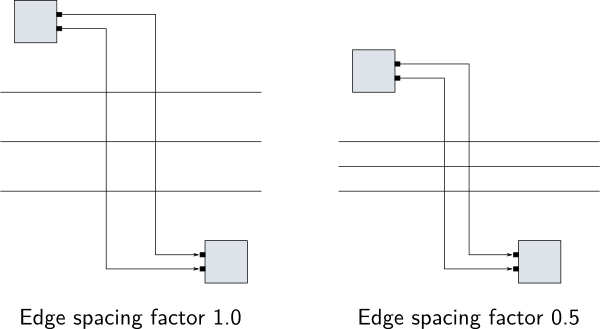
Edge Label Side SelectionDetermines how KLay Layered places edge labels. The following strategies are available:
- ALWAYS_UP
Always places edge labels above the edge. - ALWAYS_DOWN
Always places edge labels below the edge. - DIRECTION_UP
Places edge labels above edges pointing right, and below edges pointing left. - DIRECTION_DOWN
Places edge labels below edges pointing right, and above edges pointing left. - SMART
Uses a heuristic that determines the best edge label placement, also taking the placement of port labels into account.
Feedback EdgesFeedback edges are edges that feed the output of a node back to be the input of a previous node. This option controls how feedback edges are routed if port constraints are FREE. This influences how much emphasis is put on feedback edges.
With feedback edges:
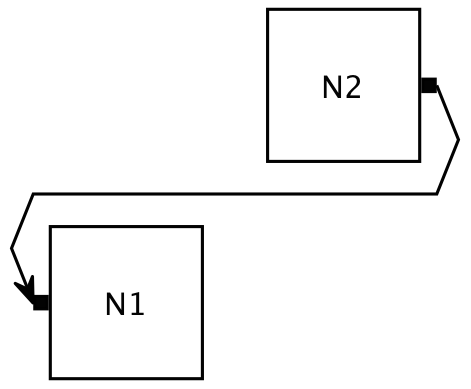
Without feedback edges:
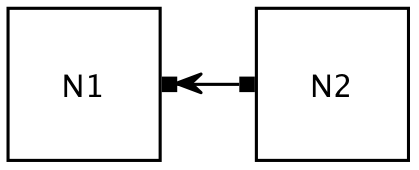
Fixed AlignmentThe BRANDES_KOEPF node placement algorithm computes several different node placements. One of the placements is chosen by the algorithm, usually the one that takes the least amount of space. With this option, a particular result can be chosen.
This option should usually be left alone.
Interactive Reference PointInteractive layering, crossing minimization, and cycle breaking algorithms use node positions to sort nodes into layers or to determine the order of nodes in each layer. However, it is unclear if for example the top left corners of nodes should be compared, or the bottom left corners — different settings might lead to different results. The interactive reference point determines which part of nodes is used to compare their positions. It provides the following settings:
- TOP_LEFT
The top left corner of a node is taken as the reference point. - CENTER
The center of a node is taken as the reference point.
Layer ConstraintThe layer a node is placed in is usually computed by the layer assignment algorithms. However, sometimes certain nodes need to be placed in the first or in the last layer (for example, nodes that represent inputs from the outside). The layer constraint option can be set on such nodes to do just that.

Linear Segments Deflection Dampening
The linear segments node placer can sometimes place nodes in a way that results in unnecessarily large diagrams. This option dampens how much the nodes are moved around. A dampening factor of 1.0 disables dampening and just lets the node placer do what it wants. A more conservative dampening factor of 0.3 (the default) restricts the freedom of the node placer a bit more.
Maximal IterationsDelimits the amount of depth-first-search iterations performed by the network simplex layering strategy. Large, highly connected graphs might require a long time to be processed. This property serves as a timeout after which an exception is raised.
Merge EdgesIn the KGraph model, edges can either connect to nodes through ports or directly. In the latter case, KLay Layered will introduce a virtual port for each edge, which results in all edges connecting to the node at different points in the final drawing. If this option is switched on, KLay Layered will only generate up to one input and one output port for each node. The option is set on a parent node and applies to all of its children, but not to the parent node itself.
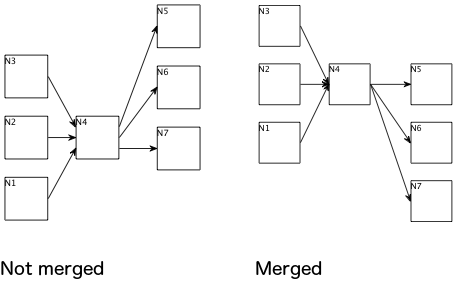
Merge Hierarchy-Crossing EdgesIf hierarchical layout is active, this option is the hierarchical equivalent to Merge Edges. If set to true on a compound node, all hierarchy-crossing edges that start or end inside that compound node are eligible for merging.
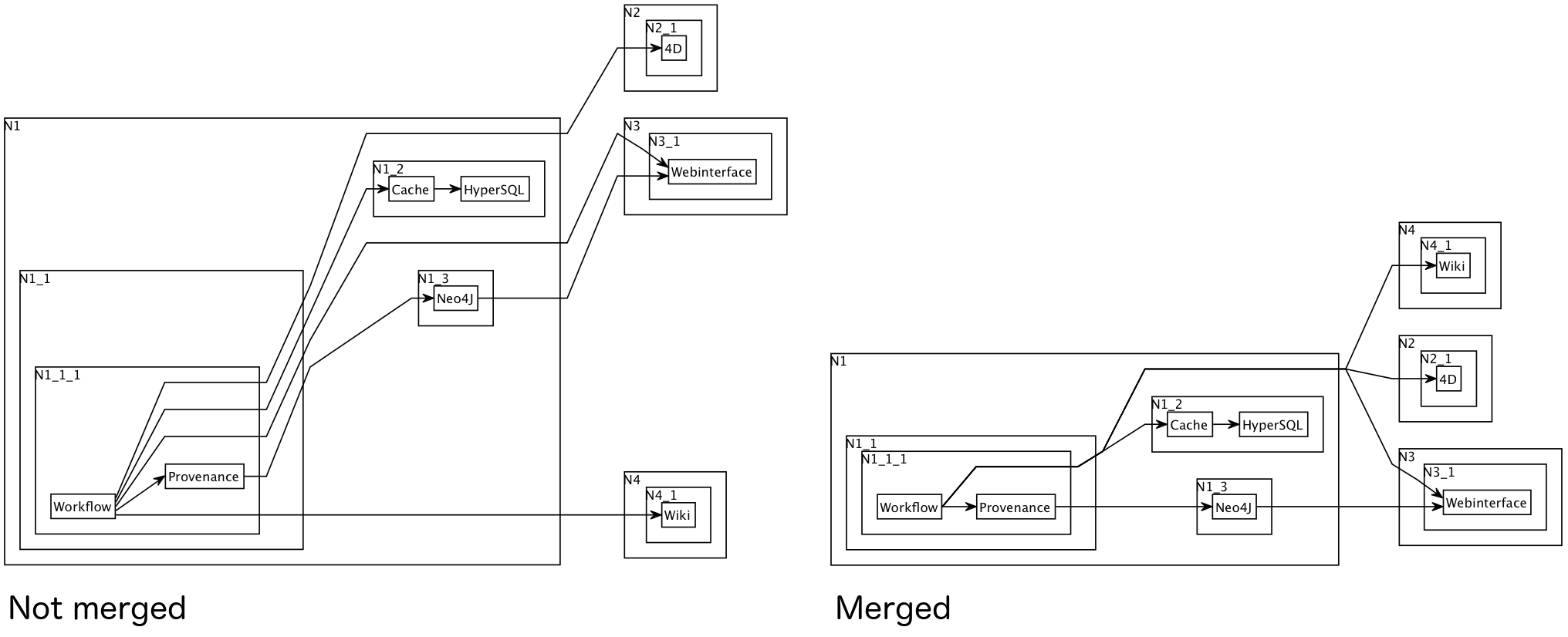
Node LayeringDecides which algorithm is used to compute the layer each node is placed in. We have different algorithms available, with different optimization goals:
- NETWORK_SIMPLEX
This algorithm tries to minimize the length of edges. This is the most computationally intensive algorithm. The number of iterations after which it aborts if it hasn't found a result yet can be set with the Maximal Iterations option. - LONGEST_PATH
A very simple algorithm that distributes nodes along their longest path to a sink node. - INTERACTIVE
Distributes the nodes into layers by comparing their positions before the layout algorithm was started. The idea is that the relative horizontal order of nodes as it was before layout was applied is not changed. This of course requires valid positions for all nodes to have been set on the input graph before calling the layout algorithm. The interactive node layering algorithm uses the Interactive Reference Point option to determine which reference point of nodes are used to compare positions.
Node PlacementDecides which algorithm is used to compute the y coordinate of each node. This influences the length of edges, the number of edge bends, and the height of the diagram. We have different algorithms available, with different optimization goals:
- BRANDES_KOEPF
Minimizes the number of edge bends at the expense of diagram size: diagrams drawn with this algorithm are usually higher than diagrams drawn with other algorithms. - LINEAR_SEGMENTS
Computes a balanced placement. - INTERACTIVE
Tries to keep the preset y coordinates of nodes from the original layout. For dummy nodes, a guess is made to infer their coordinates. Requires the other interactive phase implementations to have run as well. - SIMPLE
Minimizes the area at the expense of... well, pretty much everything else.
ThoroughnessThere are heuristics in use all over KLay Layered whose results often improve with the number of iterations computed. The thoroughness is a measure for telling KLay Layered to compute more iterations to improve the quality of results, at the expense of performance.